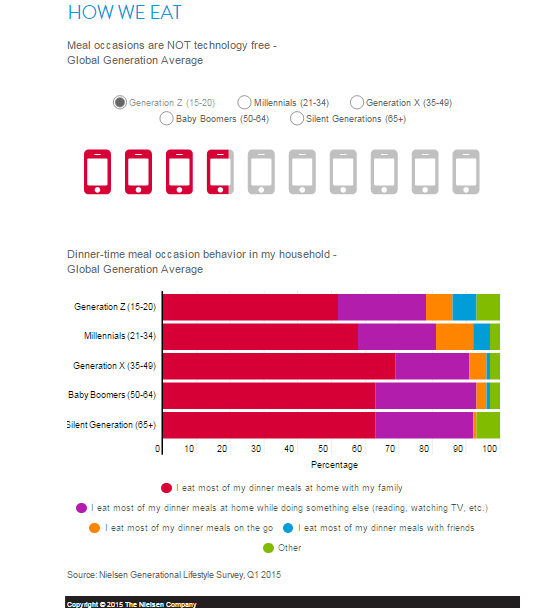 Which generation is distracted most by technology at mealtimes, and which generation eats away from home most frequently? The findings from a recent Nielsen global survey may surprise you.
Which generation is distracted most by technology at mealtimes, and which generation eats away from home most frequently? The findings from a recent Nielsen global survey may surprise you.
In this second of a five-part series about the differences between how generations live, play work and save, we focus on how consumers eat.
MILLENNIALS ARE DISTRACTED, BUT THEY’RE NOT THE ONLY ONES
Millennials are often perceived to be constantly connected to their electronic devices, but it turns out that older respondents are more distracted by their devices than their younger counterparts during mealtime. Fifty-two percent of Baby Boomers and 42% of Silent Generation respondents say their mealtimes are not technology free, compared with 40% of Millennials and 38% of Generation Z. Similarly, the highest percentages of Baby Boomers and Silent Generation respondents say they eat most of their dinner meals at home while doing something else, like reading or watching TV, at 30% and 29% respectively.

TIME AND MONEY MAY BE IN SHORT SUPPLY, BUT YOUNGER CONSUMERS EAT OUT MORE OFTEN
Nearly six-in-10 Millennials (58%) say they eat out at least once a week, twice the percentage of Baby Boomers (29%). And 30% of Millennials say they eat out three or more times per week. Generation Z and Millennial respondents also show a preference for convenience when eating away from home, as 52% in each group say they eat at quick-service restaurants, and 28% say they eat at street food vendors frequently. Conversely, 61% of Baby Boomer and Silent Generation respondents indicate a preference for full-service restaurants.

Other findings from the Global Generational Lifestyles Report include:
The majority of older respondents turn to TV to get the news, but the medium still holds sway for nearly half of Millennial (48%) and Generation Z (45%) respondents.
Reading was selected as a top spare-time activity among Generation Z—higher even than playing video games or reviewing social media.
Millennials are roughly two times more likely than Generation X to leave their current job after two years.
More than half of Generation Z and Millennial respondents (52% and 54%, respectively) want to live in a big city or urban neighborhood.
Approximately half of younger respondents say they save money each month, but they aren’t confident in their financial futures.
The Nielsen Global Generational Lifestyles Survey polled 30,000 online respondents in 60 countries to better understand how global consumer sentiment differs across life stage. For the purposes of this study, respondents are segmented into five life-stage classifications: Generation Z (age 15-20), Millennials (21-34), Generation X (35-49), Baby Boomers (50-64) and Silent Generation (65 and older).

